In a way, the economic downturn could be viewed as a good thing. If you look at it from the perspective of the motorcycling world, that’s when the hectic craze of updating the leanest and meanest sportbikes every two years came to an end.
Yamaha’s YZF-R6 and Honda’s CBR600RR (and CBR1000RR) have been practically the same for at least four years. Suzuki and Kawasaki have only recently updated their sportbikes, and even Ducati’s 1198 (and 1098 before that) is virtually the same.
Triumph, too, is guilty of not updating its supersport machine, the Daytona 675, for some time. Introduced in 2006, five years later and the bike is basically the same. Yes, it got a few minor upgrades in 2009, but hardly enough to call it a major revamp. Honestly, we’re not complaining too much. The era of the constant updates kept us on our heels trying to stay current on all the changes. And really, the Daytona 675 is a damn good motorcycle.
But there’s always room for improvement. Enter the 2011 Triumph Daytona 675R. Taking a page out of Ducati’s book, when deciding to upgrade the base 675 by adding the letter “R” at the end, the boys in Hinckley added a touch of exclusivity by turning to Ohlins for some top-shelf suspension components.
Instead of the 41mm Kayaba units on the standard bike, a 43mm NIX30 fork makes its way onto the R model — the same unit used by many AMA teams. Out back sits Ohlins’ top-of-the-line TTX36 shock, itself a similar unit used by a host of AMA and international race teams. Until now this was a level of suspension technology that was only starting to trickle down to exotic Italian literbikes.
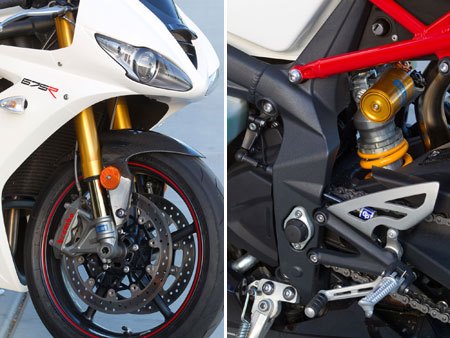 These two photos sum up the difference between the standard and R model. Ohlins NIX30 fork and Brembo monobloc calipers in front, accompanied with a TTX36 shock out back. Note also the factory quickshifter. |
To take it one step further, Triumph also hit up Brembo to make sure the new bike stops as well as it looks. The company’s four-pot monobloc calipers, which are starting to become the gold standard in stopping technology, are radially mounted and bite on 308mm discs. A Brembo radial-mount master cylinder replaces the standard Nissin unit and has an 18mm diameter (1mm smaller than the Nissin) for better feel from the stronger calipers.
Other than that the 675R doesn’t vary too much from the standard model. The same 675cc, liquid-cooled, DOHC, 12-valve three-cylinder engine remains, albeit with minor EFI tweaks to improve fueling. It’s mated to the same six-speed, close-ratio gearbox, only now the R model comes equipped with a quickshifter from the factory (It’s an option on the base model).
Other changes are purely cosmetic. Carbon fiber adorns the front fender, the rear subframe is powdercoated red, wheels get red pinstripes, and the bodywork gets a dynamic new paint job and graphics kit. We’ve always thought the standard 675 was one of the more eye-pleasing middleweights, and the R model takes the eye candy to another level.
Street Manners
If you’ve been paying attention to the site lately, you’ll remember that Triumph introduced the newSpeed Triple alongside the Daytona 675R in the rolling hills of Idyllwild, California, as part of a two-day adventure that would see us spend the second day at Chuckwalla Valley Raceway. We spent equal amounts of time on both bikes on the street and on the track.
There really is no point to beat around the bush here: the 675R is downright grueling on the street unless your front door opens to a canyon road. This bike is honed for the track, and the ergonomics punish you for doing anything else. The tail sits high while the clip-ons are low. Seat height is on the taller side for a sportbike, at 32.7 inches, and to add insult to injury there’s not much padding to be found there, either. Head in a straight line for any length of time and your wrists will curse the day you were born.
That’s not to say that riding on the street was a pointless endeavor, however. As in years past, we’ve enjoyed the class-leading torque of the 675 engine. Triumph claims 124 horsepower and 53 ft.-lb of torque at the crank, and accessing that power is as seamless as ever. Fuel delivery is crisp, especially when applying the throttle on corner exits, and now with the electronic quickshifter that operates above 2400 rpm, banging up through the gears is done with a simple flick of the left toe. Even at street speeds. No need to touch the clutch or blip the throttle. Notchy transmissions have been one of the few complaints we’ve had with the Triumph in the past. Not anymore.
The R’s track-oriented suspension is best suited for the smoothness of the racetrack, and as set up by Triumph, riding along on SoCal’s terribly maintained roads posed another challenge to the health of my joints. Damping rates were on the stiff side, causing every pimple in the road to be felt through the bars. We wished we had the time and the tools to soften the fully adjustable suspension for better bump absorption. That said, the 675R is eager to lean over and does so with just a mere thought.
Our street ride never provided the opportunity to really test the brakes. Our initial reaction is that they’re strong but not a huge step above the stock Nissin units. A true evaluation would have to wait until the racetrack.
Let’s Get Right To It
Chuckwalla Valley Raceway proved to be the perfect venue to put the 675R through its paces. The tight and technical course suits the bike’s strengths, as it’s never completely vertical for very long.
Straight away, the aggressive ergos that were torturous on the street proved right in its element at the track. The rider is perched in the attack position, ready to go from full tuck to knee-down in an instant.
The sweet symphony coming from the 675R’s tailpipe whenever the throttle is twisted is truly intoxicating, and the torque advantage it has over its 600cc competition is a benefit when exiting slow-speed corners, of which there are several on this track. The quickshifter which was impressive on the street was even more so on the track. Never was an upshift missed or accidentally engaged.
A slipper clutch is not included on the 675R as Triumph test riders don’t feel it to be necessary, but it is available as an option. Personally, I didn’t feel it needed one either. Even though there weren’t any other 600s in attendance to perform a direct comparison, relatively speaking, the Trumpet does seem to run out of breath near redline. This is something we’ve noticed before, and it’s especially noteworthy given that its Japanese counterparts would pull away at this point.
But the real test of the 675R would be how its Ohlins suspenders and Brembo stoppers perform in their intended environment. They mostly didn’t disappoint. We had the opportunity to sample a standard 675 back-to-back with the 675R, and the two are 98% identical. Overall, the base model’s damping rates are softer than the Ohlins bits on the upgraded version. Which is shocking to say since the standard bike is quite a competent performer.
The advantage of the Ohlins NIX30 fork compared to conventional forks is that one leg is dedicated to compression damping while the other handles rebound, each with just a single 30mm cartridge per leg. Out back, the TTX (Twin Tube Technology) shock completely isolates the compression and rebound circuits for precise adjustments. Shim-piston designs — which are seen on practically all other OEM suspensions — share a common bleed in the rebound circuit, which means that changes to one could affect the other.
On track the difference was small but noticeable. Suddenly the smallest imperfections on the track that weren’t noticed on the standard bike were felt on the R model. The R turns with eager agility, and thanks to the Ohlins bits you can pilot the bike with razor-sharp accuracy. Clearly, these are a cut above the already impressive stock units on the standard 675.
The only complaint I had, which was shared by a number of journos at the intro, was a chattering problem from the front end under hard braking. Ohlins sent two of their master technicians to help us tweak the setup and initially dialed back preload by two turns. While this helped, the stuttering never fully went away. Of course, your experience will vary depending on a myriad of conditions.
But this brings us to the cause of the chatter in the first place: the brakes. By now Brembo monoblocs are synonymous with stopping on a dime. We were impressed with the standard bike’s Nissin calipers, but there is no doubt the Brembos provide more bite and power. Lever feel and modulation are also superb as one would expect.
The big question here is whether they’re worth it. And to that I’d say... I don’t know. Perhaps a national-caliber racer could feel a difference and use it to shave fractions of a second, but at my pace it’s simply a non-issue. That being said, Triumph would have been silly not to fit top-shelf brakes to complement the equally exclusive suspension.
One-Track Mind
To be blunt; if you’re thinking about purchasing a 675 and plan on keeping it on the street or do the occasional trackday, we could make the case for simply getting the standard model and saving $1500 – it’s still an excellent package. But if you’re a track junkie looking for the absolute best three-cylinder middleweight, look no further than the 675R (at least until the MV Agusta F3 comes out, anyway).
If you want to spruce up the 675R even more, Triumph accessories include an Arrow exhaust, factory race kit, adjustable billet rear-sets, anodized machined-billet components (in red or black), and a gel seat. All of which come with a two-year unlimited mileage warranty.
Like the new Speed Triple, the Daytona 675R will be in dealers before the summer. Pricing is set at $11,999.
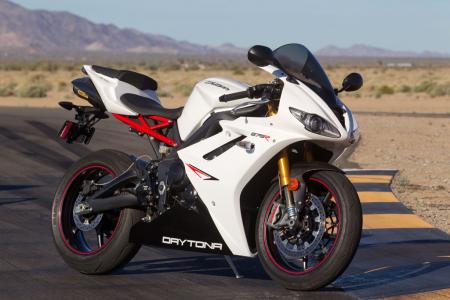 The 2011 Triumph Daytona 675R. Can Ohlins suspension and Brembo brakes make one of our favorites that much better?
The 2011 Triumph Daytona 675R. Can Ohlins suspension and Brembo brakes make one of our favorites that much better?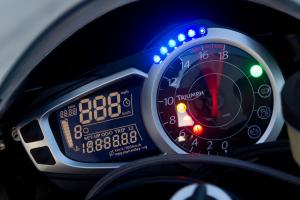 An analog tachometer is big, easy to read, and features a programmable shift light. The digital display for 2011 now features a black background with white letters for reasons unbeknownst to us (the standard model gets the same treatment). Unfortunately, the gauges are now hard to read, especially during bright sunlight.
An analog tachometer is big, easy to read, and features a programmable shift light. The digital display for 2011 now features a black background with white letters for reasons unbeknownst to us (the standard model gets the same treatment). Unfortunately, the gauges are now hard to read, especially during bright sunlight.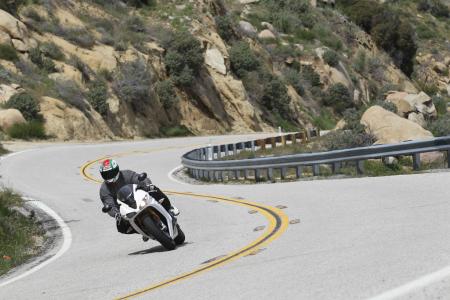 The 675R’s ergonomic triangle places a lot of pressure on a rider’s hands. Street riding is preferable if your driveway intersects a road like this, where you’ll be so entertained you’ll forget about sore wrists.
The 675R’s ergonomic triangle places a lot of pressure on a rider’s hands. Street riding is preferable if your driveway intersects a road like this, where you’ll be so entertained you’ll forget about sore wrists.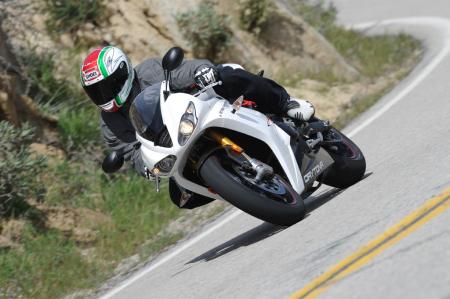 If you do decide to take it on the street, the 675R will be quick to chew up bends like this.
If you do decide to take it on the street, the 675R will be quick to chew up bends like this.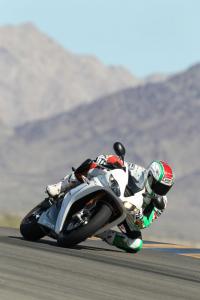 Leaned over on the racetrack is the 675R’s natural environment.
Leaned over on the racetrack is the 675R’s natural environment.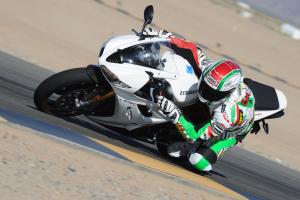 The 675R can be ridden with pinpoint accuracy on the racetrack.
The 675R can be ridden with pinpoint accuracy on the racetrack.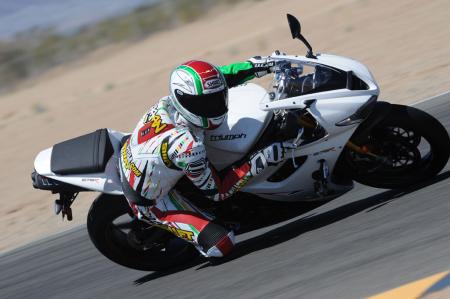 On the brakes is when the one chink in the 675R’s armor becomes revealed. We experienced a slight chatter problem that never got fully dialed out.
On the brakes is when the one chink in the 675R’s armor becomes revealed. We experienced a slight chatter problem that never got fully dialed out.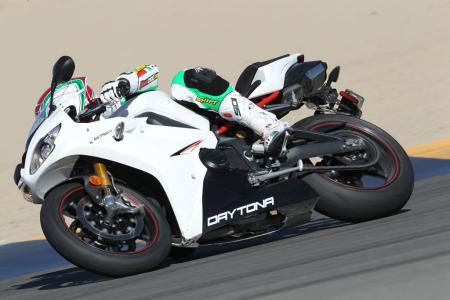 If a pure track bike is what you’re after, and you want something outside the four-cylinder norm, look no further than the Triumph Daytona 675R.
If a pure track bike is what you’re after, and you want something outside the four-cylinder norm, look no further than the Triumph Daytona 675R.
No comments:
Post a Comment